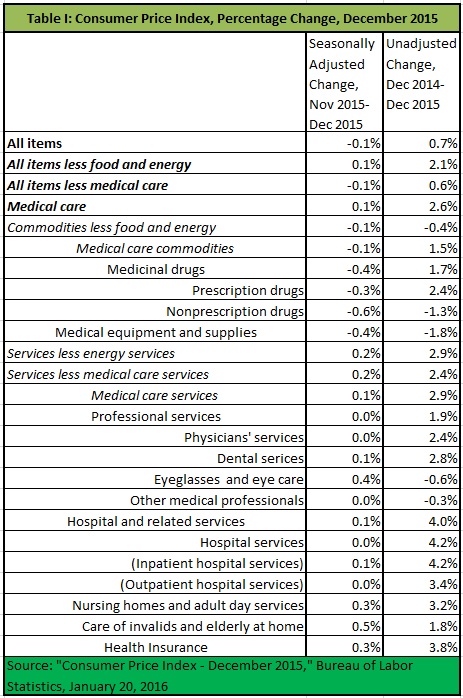CPI: Prescription Prices Finally Drop Amid General Deflation
 Medical prices grew 0.1 percent, versus a decrease of 0.1 percent for all other items, in December’s Consumer Price Index. Prices for prescription drugs actually decreased 0.3 percent, even better than the small price increase in the Producer Price Index (PPI).
Medical prices grew 0.1 percent, versus a decrease of 0.1 percent for all other items, in December’s Consumer Price Index. Prices for prescription drugs actually decreased 0.3 percent, even better than the small price increase in the Producer Price Index (PPI).
Prices for physicians’ services were flat, however, whereas they had jumped in the PPI. Because CPI measures prices as observed by consumers and PPI prices as observed by producers, this suggests that prices paid to physicians by non-consumers (i.e., third parties) have increased more than prices paid by consumers. This supports the principle that when consumers face prices directly, prices go up less than when intermediated by third parties.
Overall, medical care inflation was tame in December. Longer term, it still significantly outpaced the CPI other than medical care, by two percent over the year (Table I).



John, thanks again for the price update. BTW my latest financial article on the health care sector references one of your Forbes columns on the ACA exchanges: http://alfidicapitalblog.blogspot.com/2016/01/ultimate-lessons-from-jp-morgan.html
Thank you. I wish I had been able to go to JP Morgan conference this year. It is the best!
John, my drug insurances premium jumped 23%. So prices stabilize and insurance goes up. What’s the deal?
I can’t say except that there is variance in plan premiums.
This is the fourth year on Medicare for myself and my wife. The 2016 monthly premium for our AARP / United Healthcare Medicare Rx Preferred Plan is 78% higher than the 2012 premium was for the same plan and it’s up 21.9% from 2015. Something doesn’t add up here and I don’t think it’s adverse selection. I think it’s aggressive price increases implemented by drug companies and the very high cost of new specialty drugs.